Sociable Weaver Birds and Their Giant Nests in the Kalahari
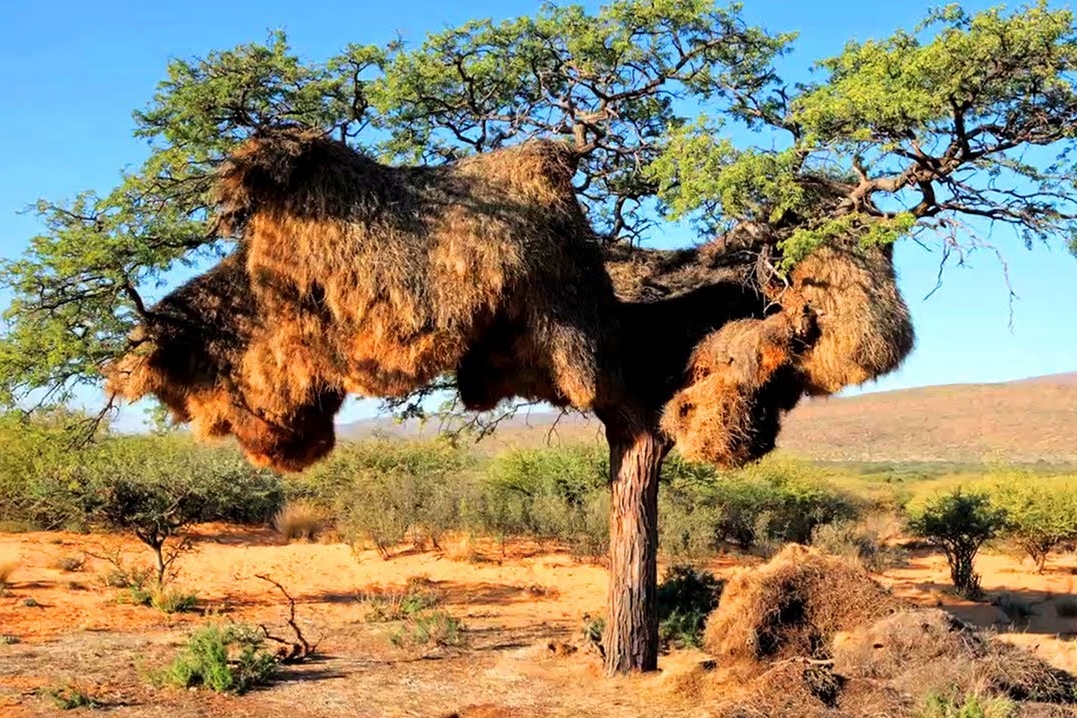
Sociable Weaver Nests ( Photo: Sandiegozoo )
In the remote and arid landscapes of the Kalahari Desert in South Africa, Namibia, and Botswana, a seemingly ordinary bird called the sociable weaver (Philetairus socius) undertakes extraordinary architectural feats, constructing colossal communal nests that have captured the curiosity of scientists and bird enthusiasts alike.
The Marvel of Sociable Weaver Nests
The sociable weaver is a small, unassuming bird that blends into the sandy backdrop of the Kalahari with its brown, grey, and black plumage. However, its nest is anything but inconspicuous. These nests, resembling giant haystacks, are built on diverse structures such as quiver trees, thorn trees, windmills, and notably, telephone poles. The nests are crafted through collaborative effort, with each bird contributing grass and straw to create a massive, intricately woven structure.
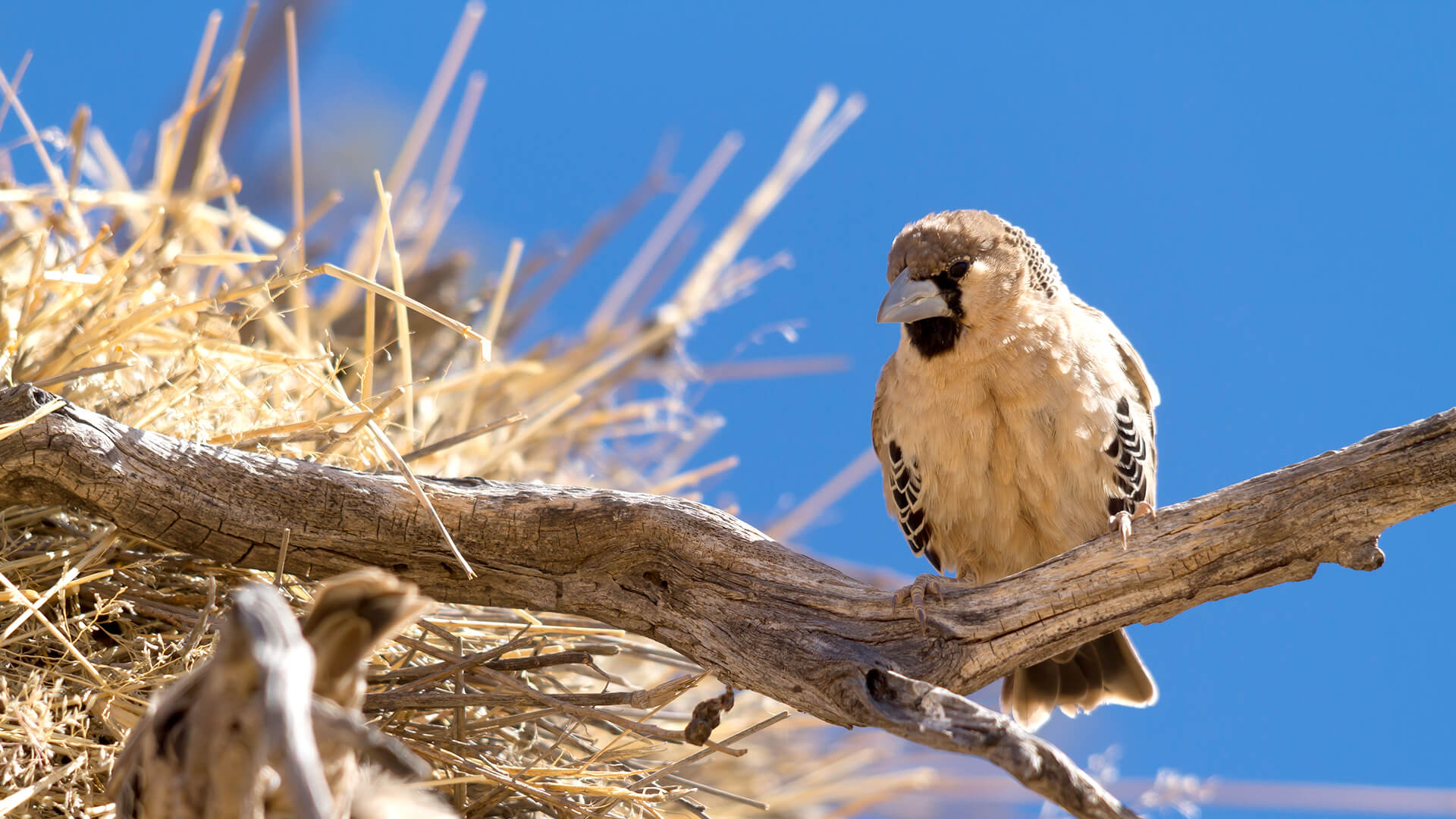
Sociable Weaver ( Photo: Sandiegozoo )
Diversity and Distribution
Sociable weavers are endemic to South Africa, Namibia, and Botswana, primarily inhabiting the arid savannahs of the southern and western Kalahari regions. Their distribution is closely tied to the presence of specific vegetation, such as stiff grasses crucial for nest building.
Unparalleled Nesting Behavior
What sets the sociable weaver apart is its year-round use and maintenance of these nests, unlike other weaver species that construct nests solely for breeding purposes. These nests are communal, housing anywhere from 10 to 500 birds, and they can reach heights of up to 4 meters. The nests are not only shelters but also serve as hubs for multiple bird species, embodying a fascinating example of interspecies cohabitation.
Engineering Wonders
The construction of these nests is a testament to avian engineering. The birds meticulously select different materials for specific parts of the nest, strategically placing large twigs on the roof and weaving grasses into the structure for stability and insulation. The design is not just functional but also serves as protection against predators, with sharp grass spikes fencing the tunnel entrances.
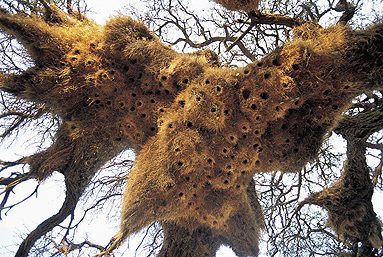
Sociable Weaver Nest ( Photo: DON BOROUGHS )
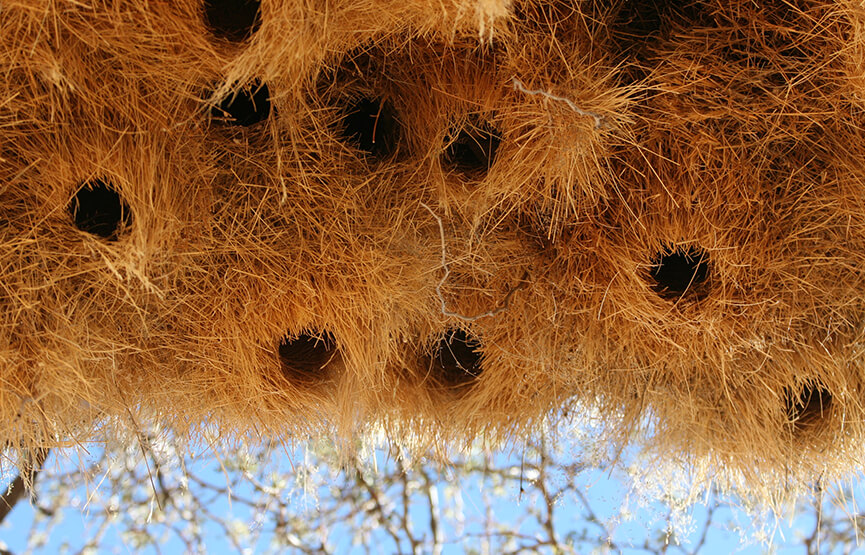
Sociable Weaver Nest ( Photo: Sandiegozoo )
Challenges for Infrastructure
While these nests are marvels of nature, they pose unique challenges for infrastructure in the region. Telecommunication and power companies have grappled with designing poles and structures that can withstand the weight of these nests, particularly during the rainy season when the nests become waterlogged and heavy, sometimes causing poles to collapse.
Surviving Extreme Conditions
The Kalahari Desert is characterized by extreme temperatures, with freezing nights in winter and scorching heat in summer. The sociable weaver's nest acts as a thermal buffer, providing moderate temperatures inside even as the outside environment fluctuates drastically. This insulation is critical for the survival of these small birds, reducing their energy expenditure on regulating body temperature.
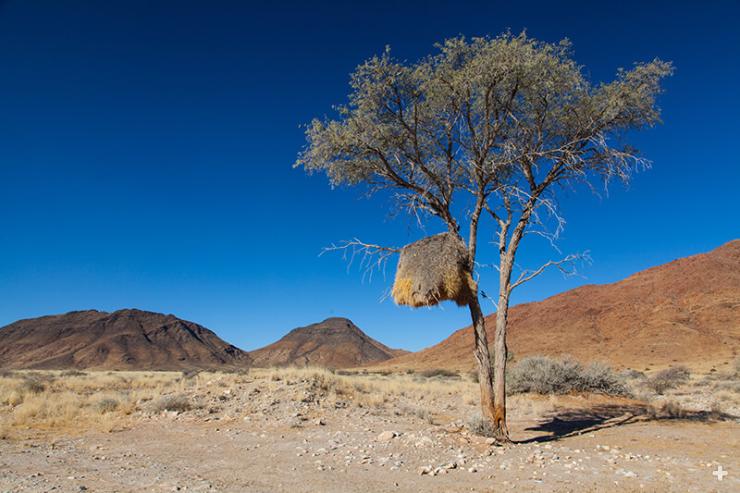
Sociable Weaver Nests in the Kalahari ( Photo: Sandiegozoo )
A Complex Social Structure
Within these vast nests, sociable weavers exhibit complex social behaviors. They huddle together in chambers during cold nights, conserving energy by up to 50%. In the heat of the day, they retreat to shaded areas within the nest, demonstrating remarkable adaptation to the desert environment.
Environmental Triggers for Breeding
The weavers' breeding behavior is intricately linked to environmental cues, such as rainfall. A sudden downpour, even out of season, can trigger breeding activity within the colony. With sufficient resources, these birds can raise multiple broods, often aided by offspring from earlier broods and even unrelated helpers.
Conservation Implications
Studying sociable weaver behavior offers insights into adaptation strategies for survival in harsh environments. As climate change impacts these delicate ecosystems, understanding how these birds thrive in extreme conditions could inform conservation efforts aimed at preserving biodiversity in arid regions.
Exploring the Kalahari's Avian Diversity
For bird enthusiasts, the Kalahari offers a unique opportunity to witness the sociable weaver and its impressive nests firsthand. Game reserves like the Kgalagadi Transfrontier Park provide ideal settings for observing these birds in their natural habitat, offering a glimpse into the intricate world of avian architecture and social dynamics.
Conclusion
The sociable weaver's ability to create and maintain massive communal nests stands as a testament to nature's ingenuity. These birds have evolved remarkable strategies to thrive in one of the world's harshest environments, showcasing the power of collaboration and adaptation in the face of adversity.
Frequently Asked Questions (FAQs)
1. How old can sociable weaver nests get? Some sociable weaver nests have been documented to be over 100 years old, showcasing the durability and longevity of these architectural wonders.
2. What other bird species inhabit sociable weaver nests? Sociable weaver nests often host a variety of bird species, including African Pygmy Falcons, Pied Barbets, Rosy-faced Lovebirds, Familiar Chats, finches, sparrows, tits, and various vultures and owl species.
3. How do sociable weavers cope with extreme temperatures? The nests act as thermal buffers, providing insulation from cold nights and shade during hot days. Sociable weavers employ collective behaviors like huddling to conserve energy and regulate body temperature.
4. What is the significance of these nests for conservation? Studying sociable weaver behavior informs conservation efforts in arid environments, highlighting adaptive strategies that could be vital for preserving biodiversity in changing climates.
5. Where is the best place to observe sociable weavers and their nests? Game reserves and national parks in the Kalahari, such as the Kgalagadi Transfrontier Park, offer ideal locations for birdwatching and studying sociable weaver colonies and their impressive nests.
Source : Africa Geographic, South Africa.net




